Timeline of Karnataka
| Karnataka and Kannada | |
|---|---|
| Type | |
| Languages | Kannada |
Time period | c. 230BCE–present |
| Direction | Left-to-right |
| ISO 15924 |
Knda, 345 |
Unicode alias | Kannada |


The name Karnataka is derived from "Karunadu" which means Loftyland (High plateau), derived from the community's location on the Deccan Plain. The name can also mean "Land of black soil" (Kari - Black; Nadu - Area or Region) in Kannada. The history of Karnataka goes back to epics "Ramayana" and "Mahabharatha". The capital of "vaali" and "Sugriva" of the epic, Ramayana, is said to be Hampi. Karnataka finds its mention in Mahabharatha in the form of "Karnata Desha". In olden times the region was also called "Kuntala Rajya".[1] Karnataka was also part of the Dakshinapatha (southern region) which finds its mention in many Indian epics. Vatapi, associated with sage Agastya is obviously Badami in Bagalkot district.[2] Karnataka is situated on the western edge of the Deccan plateau and has for its neighbours Maharashtra and Goa on the north, Andhra Pradesh on east, Tamil Nadu and Kerala on the south. On the west it opens out on the Arabian sea.
Prehistory

During 4th and 3rd century BCE, [3] Karnataka was part of Nanda and Maurya Empire. The Brahmagiri edicts in Chitradurga dated around c.230BCE belongs to emperor Ashoka and says of the nearby region as "Isila",[4] which means "fortified region" in Sanskrit. In Kannada "Isila" can mean "To shoot an arrow" ("sila" or "sala" means to-shoot and "ise" or "ese" means to-throw in Kannada). After Maurya, Shatavahana came to power in the north and ganga in the south which can roughly be taken as the starting point of Karnataka in modern times. Kavirajamarga [5] by Amogavarsha states Karnataka as the region between the Kaveri River in south and the Godavari River in north. It also says "Kavya prayoga parinathamathigal" (See Image) which means people in the region are experts in poetry and literature.
Starting period
| Time Period / Era | Empire / Dynasty | Main Rulers | Empire Extent |
|---|---|---|---|
| Starting period | Shatavahana | Semukha / Gouthamiputhra | Deccan comprising present Andhra, Karnataka, Maharashtra |

Around 3 BCE the Shatavahana came to power. The Shatavahanas ruled parts of northern Karnataka. They used Prakrit [6] as the administrative language and they either belong to Andhra or Karnataka. Both Kannada and Telugu were found from their periods and gradually rose to prominence in their respective regions. Semukha and Gouthamiputhra Shatakarni were important rulers. The empire lasted for almost 300 years. With the disintegration of Shatavahana Empire, the Kadambas came to the power in the north of Karnataka and the Gangas in the south.
Banavasi Kadamba
| Time Period / Era | Empire / Dynasty | Main Rulers | Empire Extent |
|---|---|---|---|
| A.D.325 - A.D.540 | Banavasi Kadamba | Mayura Sharma / Kakustha Varma | Central, Northern Karnataka, parts of Southern Maharashtra |
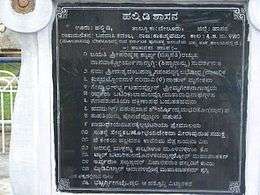
The Kadambas [7] are considered the earliest indigenous rulers of Karnataka. Its founder was Mayurasharma and its most powerful ruler was Kakusthavarma. The Kadamba name is attributed to the Kadamba tree that was grown near the place where the empire was founded. Kadambas ruled for almost 200 years before Chalukyas took over their empire, but some minor branches of Kadambas ruled Hanagal, Goa and other regions till 14th century. The details about this old empire is available through inscriptions like Chandravalli, Chandragiri, Halmidi, etc.
Gangas of Talakad
| Time Period / Era | Empire / Dynasty | Main Rulers | Empire Extent |
|---|---|---|---|
| CE.325 - CE.999 | Gangas of Talakad | Avanitha / Durvinitha / Ratchamalla | South Karnataka / parts of Andhra and Tamil Nadu |

The Gangas first ruled from Nandagiri and then from Talakad. They were patrons of Jain and Hindu religions. They were also instrumental in laying a strong foundation for the flourishing and development of Kannada literature. They ruled for almost 700 years. During their peak period the empire included Kodugu, Tumkur, Bangalore, Mysore districts, parts of Andhra and Tamil Nadu. Durvinitha, Shripurusha and Ratchamalla were famous rulers. The most famous example of Ganga architecture is the Gomateshwara in Shravanabelagola [8] built in c. 983 CE by the ganga minister "Chavundaraya". The statue is carved out of a single monolith rock and measures 57 feet high. This is the tallest monolith statue in the world and is so perfect that fingers of the hand is cut up slightly as a mark of induced imperfection (Drushti Nevarane in Kannada). The statue is naked and shows the beauty of the human in that form. The statue is first of its kind in karnataka and comparable statues were not produced thereafter.
Chalukyas of Badami
| Time Period / Era | Empire / Dynasty | Main Rulers | Empire Extent |
|---|---|---|---|
| CE.500 - CE.757 | Chalukyas of Badami | Pulakeshin II / Vikramaditya II | Most of Karnataka and Maharashtra, large parts of Andhra Pradesh, parts of Madhya Pradesh, Gujarat, Orissa |

The Chalukya empire was established by Pulakeshin.[9] His son Kirtivarma consolidated and strengthened the empire. Mangalesha who was a powerful ruler extended the empire. The name "Chalukya" has no definite meaning. According to legend the brave man who was born out of god Brahma's Cheluka (a type of vessel) was named Chalukya. They were patrons of deity Vishnu. The most famous ruler was Pulakeshin II (c. 610 CE - c. 642 CE). He was having the title of "Satyasherya Parameshwara" and "Dakshina Patheshwarya" because he defeated most of southern and northern rulers including Harshavardhana of Kanouj. During his rule the empire extended up to the south of Karnataka and included the whole of western India (i.e. Gujarat, Maharashtra). Later victories also brought the eastern portions (Orissa, Andhra) into his rule. Chinese traveller Xuanzang [10] visited his court and called the empire "Maholocha" (Maharashtra). His description included Pulakeshin 2nd's personal details and military techniques that was employed. An artistic picture in Ajanta depicts the arrival of representative of Persian emperor Kusru 2nd to his kingdom. Pulakeshin 2nd was finally defeated by Pallava ruler Narasimhavarman who occupied Badami and called himself "Vatapikonda", which literally means "The one who won Badami". The end of Pulakeshin 2nd is still a mystery. But the empire could last up to 757 CE.[3] Their contribution to architecture include cave temples of Badami, Aihole, Pattadakal, Mahakoota, etc.
Rastrakuta of Manyakheta
| Time Period / Era | Empire / Dynasty | Main Rulers | Empire Extent |
|---|---|---|---|
| CE.757 - CE.973 | Rastrakuta of Manyakheta (modern Malkhed) | Druva Dharavarsha / Krishna I / Govinda III / Nrupatunga Amoghavarsha I / Indra IV / Krishna III | All of Karnataka and Maharashtra, large parts of Andhra Pradesh, Tamil Nadu, Madhyapradash, extended to Kannauj at their peak. |
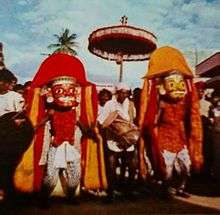
The name Rastrakuta [11] is a formal title like Patela, Gowda, Hegade, etc. Dantidurga and his son Krishna overtook the empire from Chalukyas and built a powerful empire on it. During the rule of Govinda,the empire became more powerful all over the south and the north. His son Nrupatunga Amogavarsha got immortalised as "Kavichakravarthi" due to the work of Kavirajamarga. In c. 914 CE Arab traveller Hassan-al-masood visited the empire. The 10th century was a golden period for the literature of Kannada. The famous poet "Pampa" was in the court of Arikesari who was a feudatory to Rastrakutas. Adikavi Pampa popularised the "Champu" style through the epic "Vikramarjuna Vijaya". Other famous poets who lived in this period are Ponna, Ranna, etc. among others. During c. 973 CE Taila 2nd of Chalukya defeated the Rastrakutas after prolonged battle taking advantage of Karka 2nd's (the last ruler of Rastrakutas) weakness. The world famous Kailash Temple at Ellora is an excellent example for their architecture.
Chalukyas of Kalyana
| Time Period / Era | Empire / Dynasty | Main Rulers | Empire Extent |
|---|---|---|---|
| CE.973 - CE.1198 | Chalukyas of Kalyana | Vikramadithya VI | Entire Karnataka and Maharashtra, large areas in Andhra Pradesh, parts of Tamil Nadu and Madhya Pradesh while at their peak |
_at_Hulikere.jpg)
After the Rastrakutha came the Chalukya who ruled from Kalyana. The most famous among them was Vikramadithya 6th. He was responsible for the setting of new era call "Vikrama shaka" .[12] An important event that took place during this period (c. 1150 CE) is the social and religious movement of Basaveshwara who was in the court of Bijjala. The literature that flourished under Basaveshwara, Allamaprabhu, Channabasavanna and Akkamahadevi during this period gave rise to "Vachanna" in Nadugannada (middle Kannada) which was simple to understand, elegant and effective in reaching the people. The Vachanna form of literature was instrumental in removing the Sanskrit influence to a large extent and thus popularised Kannada as an effective language for literature. The Kashmiri poet Bilhana came to his court and lived there. The Kalachurya took over their empire and ruled for about 20 years but were ineffective to see the integrity of the empire. Thus the empire got broke up which was shared by Sevunas in the north and Hoysalas in the south.
Sevunas of Devagiri
| Time Period / Era | Empire / Dynasty | Main Rulers | Empire Extent |
|---|---|---|---|
| CE.1198 - CE.1312 | Sevunas of Devagiri | Singana II | Northern Karnataka, most of Maharashtra and parts of Andhra Pradesh |

The Sevunas were from Nasik and came to power during c. 835 CE. They ruled parts of Deccan to its north until the beginning of 12th century and with Devagiri as the capital. Singana 2 was the main ruler and during his rule most of the empire experienced stability which could not be maintained thereafter. They were constantly at fight with Hoysalas and other rulers and fell to Delhi sultan Allah-ud-din Khilji and his general Mallikaffar. They ruled for almost five centuries.
Hoysalas of Dwarasamudra
| Time Period / Era | Empire / Dynasty | Main Rulers | Empire Extent |
|---|---|---|---|
| CE.1000 - CE.1346 | Hoysalas of Dwarasamudra | Vishnuvardhana / Ballala II | Southern Karnataka including the coast, parts of Andhra Pradesh and Tamil Nadu |
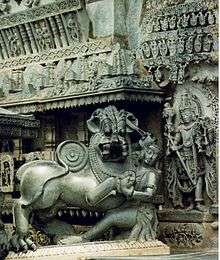
The hoysalas were famous for their architecture. The empire was founded by the legendary person "Sala" who was famous for killing a tiger and rescuing his master, and thus the empire is named Hoysala ( means - to shoot it or hit it ). According to the legend when Sala along with his master was at study in a temple a tiger attacked his master. His master gave him a Khatari (knife) and said Hoy, Sala ( Hit Sala Hit ). Sala fought with the tiger and killed it. This legend is depicted in their royal emblem and is also found in many inscriptions and in front of Belur temple. They were patrons of Jain religion. During c.8th century Shankaracharya established one of their centers at Shringeri in Chikamagalur and gave impetus to the Vidheka (Hindu) religion. After Basaveshwara, the worship of Shiva got boost in north Karnataka. Ramanujacharya established a Hindu center at Melukoote near Mysore which is still functioning. The famous king "Bittydeva" was influenced by Ramanujacharya and got converted to Hindu and changed his name to "Vishnuvardhana".[13] The world-famous temples at Belur, Halebid and Somnathpura are examples of their architecture. The famous expert in epigraphy Mr. Furgusen [14] described the architecture of "Hoysaleshwara" temple as exceeding the art of any Gothic architecture.
Vijayanagara
| Time Period / Era | Empire / Dynasty | Main Rulers | Empire Extent |
|---|---|---|---|
| CE.1336 - CE.1565 | Vijayanagara | Devaraya II / Krishnadevaraya | Most of Karnataka up to Krishna river, most areas in Andhra Pradesh, entire Kerala and Tamil Nadu |
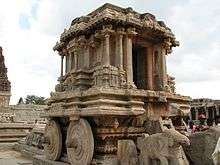
The Vijayanagara empire was founded by the duo Harihara and Bukka. The empire was established during tough times and hence only able rulers were allowed to oversee the empire and in that time Harihara who was an administrator took the empire from Hoysala Ballala in c. 1336 CE, and due to his work the empire got firmly established in c. 1346 CE [3] and blocked the Muslim invasion in the south of India and ruled for almost 200 years. Italian, Portuguese, Persion visitors (Parsee, Kantae, Abdul Razak) [15] described the Vijayanagar capital Hampi as equivalent to Rome in those days. Krishnadevaraya was the most famous ruler of the empire and was from Tuluva dynasty. The Vijayanagar empire got defeated in the battle of Talikota in c. 1565 CE by the combined army of five sultans of deccan. The stone chariot is an excellent example of Vijayanagar architecture.
Bahamani
| Time Period / Era | Empire / Dynasty | Main Rulers | Empire Extent |
|---|---|---|---|
| CE.1347 - CE.1527 | Bahumani Sultanate | Muhammadshah I / II | Deccan area comprising northern Karnataka and Andhra |
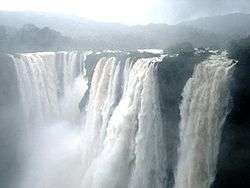
The Bahumani empire was established due to the conquest of the Muslim rulers in south India. The Muslim raids were so intense that in almost two attacks, four empires of the south were destroyed (Devagiri in c. 1318 CE, Varangal of Andhra in c. 1323 CE, Pandya of Tamil Nadu in c. 1330 CE, and partially Hoysala). But Hoysala Ballala shifted his capital to Tiruvannamallai and continued his fight. Amir-hassan from Persia called himself as Bahaman and established the Bahumani kingdom. Muhammad shah was an able ruler and strengthened the empire. Muhammad Gawan was the most famous minister under the Bahumans. They ruled from Bidar. Russian traveller Nikiten [16] visited the empire in c. 1470 CE and described Bidar as a beautiful city.
Sultans of Bijapur
| Time Period / Era | Empire / Dynasty | Main Rulers | Empire Extent |
|---|---|---|---|
| CE.1490 - CE.1686 | Sultans of Bijapur | Yusaf Addil Khan / Ibrahim Addil Shah II | Bijapur and adjoining areas |

Around c. 1490 CE the empire broke into five parts in which Bidar and Bijapur belongs to Karnataka. Muhammed-Ibrahim-adil-shah has built the famous Gol Gumbaz in Bijapur. Muslim architecture flourished under their reign but many remained uncompleted. Farista who was in the court of Ibrahim 2nd compiled an encyclopedia called "Najumal-Ullum" (star of scientists) which contained many art of southern style. The Mughals finally conquered their empire.
Nayakas of Keladi
| Time Period / Era | Empire / Dynasty | Main Rulers | Empire Extent |
|---|---|---|---|
| CE.1500 - CE.1763 | Nayakas of Keladi | Shivappa Nayaka / Rani Channama | Coastal and Central Karnataka |
The Nayakas of Keladi were ruling the coastal regions during the Vijayanagar reign. They successfully repelled the Portuguese and Bijapur sultans. They carried forward the principles and traditions of Hindu religion after the demise of Vijayanagar empire. During its peak, the kingdom encompassed regions from Goa to Kannor and included Shimoga and Hassan regions. The most famous among them was "Shivappa Nayaka" who had excellent military and administrative skills. He was famous for his taxation and agricultural systems. His land taxation system is famous as "Shivappanayakana Shisthu" (Discipline of Shivappanayaka). Another important among them was "Rani Channama". She fought with the Mughals to rescue Shivaji's son Rajarama. She got immortalised in the Kannada traditional (janapada) songs. Hyderali occupied their kingdom to Mysore.
Wodeyars of Mysore
| Time Period / Era | Empire / Dynasty | Main Rulers | Empire Extent |
|---|---|---|---|
| CE.1399 - CE.1761 | Wodeyars of Mysore | Ranadhira Kantirava / Chikkadevaraja | Southern Karnataka, parts of northern Tamil Nadu |

The Yeduraya and Krishnadeva of Yadava clan who came from Dwaraka to Mysore were approached for help to contain Marappanayaka. They defeated and killed him. His heir was married to Yeduraya and he came to crown in c.1399 CE. Mysore was previously called "MahishaMandala" which means region of demon Mahisha. The demon was killed by goddess in this region and hence got the name Mysore. The small kingdom was made into a mighty empire by RajaWodeyar. They shifted their capital from Mysore to Srirangapattana. Chikkadevaraja Wodeyar is the most famous ruler among them and got the title "Karnataka Chakravarthy" by defeating Nayakas (Ikkeri), Sultans (Mudurai) and Shivaji. By 1686 CE the kingdom included almost all of south India. In 1687 CE they bought the city of Bangalore from Mughal by paying three lakh Rupees. By 1761 CE Hyder Ali who was a normal soldier took over their empire.
Sultanate of Srirangapattana
| Time Period / Era | Empire / Dynasty | Main Rulers | Empire Extent |
|---|---|---|---|
| CE.1761 - CE.1799 | Sultanate of Srirangapattana | HyderAli / Tippu Sultan | Most of Karnataka, parts Andhra Pradesh Tamil Nadu and Kerela |

Hyder Ali who overtook the Mysore from the Wodeyars ruled from Srirangapattana. Though he was not educated, he was good at military tactics. Although he took the empire, he did not call himself the emperor but called him the Prime Minister of the empire. He continued some traditions of the Hindu Wodeyars. Tipu Sultanwho became the ruler after Hyder Ali was also very able at military tactics. He defeated and repelled the British several times. But due to lack of administrative skills he was defeated by a confideration of British, Maratha and Hyderabad Nijamas. He died on battle field in 1799 CE.
Mysore Wodeyars
| Time Period / Era | Empire / Dynasty | Main Rulers | Empire Extent |
|---|---|---|---|
| CE.1800 - CE.1831 | Mysore Wodeyars | Krishna Raja Wodeyar III | Old Mysore area |

After the defeat of Tipu, according to treaty in 1800 CE the British divided the state in which Bellary, Kadapa, Kurnool areas went to Nijamas; Marathas got the northern parts; the coastal parts were retained by the British, but they divided it among Bombay and Madras presidencies. The then governor-general of British India Markvis of Wellesley reinstated the Wodeyar in Mysore and administration was given to Dewan Purnaiya because the throne prince was still young. Purnaiya was an able administrator, and under his guidance the empire functioned like any modern government. The other ministers in line were Sir Sheshadri Aiyar, Dr. M. Visveswaraya and Sir Mirja Ismail. Around 1824 CE "Rani Channamma" and her general "Sangoli Rayanna" of Kittur started to fight against British and declared independence. Due to this, in 1831 CE the British took over the empire.
British takeover
| Time Period / Era | Empire / Dynasty | Main Rulers | Empire Extent |
|---|---|---|---|
| CE.1831 - CE.1881 | British Takeover. | Commissioners of British | Old Mysore and other areas |
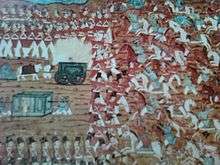
In 1831 CE the British overtook the empire and appointed the commissioners, who were given the power to rule on behalf of the British empire. Among them "Sir Lord Cubbon" was the most important. They systematically changed the way the empire functioned and brought in major changes but they continued some of the older traditions. During this period the state got divided between Bombay and Madras provinces, Hyderabad Nijamas and Mysore.
Mysore Wodeyars
| Time Period / Era | Empire / Dynasty | Main Rulers | Empire Extent |
|---|---|---|---|
| CE.1881 - CE.1950 | Mysore Wodeyars | Krishna Raja Wodeyar 4/Jayachamaraja Wodeyar | old Mysore area |
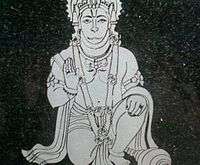
After a period of British Commissioners' rule, Mysore was given back to the Wodeyars under Jayachamaraja Wodeyar. During this period the urge to independence gained momentum with the result that many leaders were imprisoned. The struggle finally led to the grant of independence to India by the British. The rule of the Wodeyars continued until the Indian independence and finally they merged Mysore with the Indian union which got incorporated into India as a state.
Karnataka State
| Time Period / Era | Empire / Dynasty | Main Rulers | Empire Extent |
|---|---|---|---|
| CE.1956 | Karnataka State | Government | Whole of Karnataka |
After the Indian independence and partition of the country the states were reorganised based on the linguistic and other criteria and thus the divided areas of Kannada speaking population came together to form the present day Karnataka under the name of Mysore. On 1973 November 1, the name Mysore was changed to Karnataka. The state choose the city of Bangalore as its capital and gave Kannada the status of administrative language. The Vidhana Soudha build by Kengal Hanumanthya became the state parliament house. The Attara Kachery was made the state high court.
Bangalore City
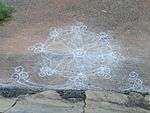
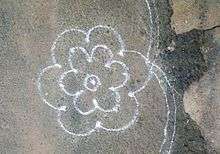
In around c.1537 CE an important event occurred that of establishment of Bangalore city by Kempegowda who was a chieftain of Yalahanka kingdom. According to popular belief, when Kempegowda went to hunting he saw a mola (rabbit) chasing a naayi (dog). He thought this as a good sign and in that place he built a fort which led to the foundation of the city of Bangalore. Pleased by this, the Vijayanagar emperor Achutaraya awarded the place around the fort to Kempegowda. Kempegowda used the money of the empire to improve the city and to make the foreign traders and local workers to settle down there. He built viewing (watching) towers and his emblems in all the four directions of the city at places like Alasuru, Hebbala, Lalbag, and Kempambudi lake. Even today they can be seen and it remains as his memories. These towers are used as emblems of Bangalore city corporation. Although the extent of the towers was large in those days, today the city has outgrown them.
Summary
The table shows the summary [17]
| Time Period / Era | Empire / Dynasty | Main Rulers | Empire Extent |
|---|---|---|---|
| Starting period | Shatavahana | Semukha, Gouthamiputhra | Deccan comprising present Andhra, Karnataka, Maharashtra |
| CE.325 - CE.540 | Banavasi Kadamba | Mayura Sharma, Kakusta Varma | Central, Western, Northwestern Karnataka |
| CE.325 - CE.999 | Gangas of Talakad | Avanitha, Durvinitha, Ratchamalla | South Karnataka, parts of Andhra and Tamil Nadu |
| CE.500 - CE.757 | Chalukyas of Badami | Mangalesha, Pulakeshin 2 | Parts of Karnataka, Maharashtra, Gujarath, Orrisa, Andhra |
| CE.757 - CE.973 | Rastrakutha of Malakeada | Krishna 1, Govinda 3, Nrupatunga Amoghavarsha 1 | Parts of Karnataka, Andra, Tamil Nadu, Madhyapradash, Maharashtra |
| CE.973 - CE.1198 | Chalukyas of Kalyana | Vikramadithya 6 | Parts of Karnataka, Andra, Tamil Nadu, Madhyapradash, Maharashtra |
| CE.1198 - CE.1312 | Sevunas of Devagiri | Singana 2 | Parts of Karnataka, Andra, Maharashtra |
| CE.1000 - CE.1346 | Hoysalas of Dwarasamudra | Vishnuvardhana, Ballala 2 | Parts of south and coastal Karnataka, Andra, Tamil Nadu |
| CE.1336 - CE.1565 | Vijayanagara | Devaraya 2, Krishnadevaraya | Most of Karnataka, Kerala, Tamil Nadu, Andhra |
| CE.1347 - CE.1527 | Bahumani | Muhammadshah 1 / 2 | Deccan area |
| CE.1490 - CE.1686 | Sultans of Bijapur | Yusaf Addil Khan, Ibrahim Addil Shah 2 | Bijapur and adjoining areas |
| CE.1500 - CE.1763 | Nayakas of Kelaedi | Shivappa Nayaka, Rani Channama | Parts of Coastal Karnataka |
| CE.1399 - CE.1761 | Wodeyars of Mysore | RajaWodeyar, Ranadhira Kantirava, Chikadevaraja | Old Mysore region |
| CE.1761 - CE.1799 | Sultanate of Srirangapatana | HyderAli, Tippu Sultan | Parts of Karnataka, Andhra |
| CE.1800 - CE.1831 | Mysore Wodeyars | Krishna Raja Wodeyar 3 | Old Mysore area |
| CE.1831 - CE.1881 | British Takeover. | Commissioners of British | Old Mysore and other areas |
| CE.1881 - CE.1950 | Mysore Wodeyars | Krishna Raja Wodeyar 4, Jayachamaraja Wodeyar | old Mysore area |
| CE.1956 | Karnataka State | Government | Whole of Karnataka |
Graphical timeline

Middle Kingdoms of India
See also
References
- ↑ "The Kuntala and its extent in Karnataka.".
- ↑ "Manorama yearbook 2002.". Malayalam Manorama. Check date values in:
|access-date=(help); - 1 2 3 "Timeline".
- ↑ "Isila and Brahmigiri Excavation Sites".
- ↑ "Kavirajamarga and Amoghavarsha.".
- ↑ "Satavahana and Prakrit".
- ↑ "Kadamba Reference".
- ↑ "Sharavanabelogala and Ganga contribution.".
- ↑ "Pulikeshi and his adventures.".
- ↑ "Huen-Tsang visit to India".
- ↑ "Rastrakutas and their empire.".
- ↑ "Vikrama Shaka and Vikramadithya.".
- ↑ "Bettydeva and VishnuVardhana".
- ↑ "Hoysaleshwara and furgusen comments".
- ↑ "Vijayanagar empire and foreign Visitors".
- ↑ "Russian Traveller to India - Nikitin".
- ↑ "Timeline of Karnataka".
